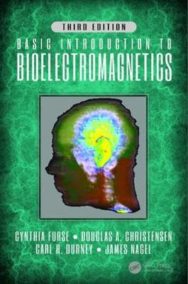
ABOUT THIS BOOK
PUBLISHER: Taylor & Francis Inc
FORMAT: Hardback
ISBN: 9781498780018
RRP: £95.00
PAGES: 368
PUBLICATION DATE:
September 3, 2018
BUY THIS BOOK
As an Amazon Associate and Bookshop.org affiliate we earn from qualifying purchases.
Basic Introduction to Bioelectromagnetics, Third Edition
Cynthia Furse
Douglas A. Christensen
Carl H. Durney
James Nagel
Basic Introduction to Bioelectromagnetics, Third Edition, is a primary source for medical technologists and life scientists seeking to understand how electromagnetic fields interact with the body, and how they are used in medical applications. Instead of the complex math commonly used when analyzing electromagnetics, this book uses graphical methods and simple equations. The third edition is updated with color graphics that show the fields in bright, clear colors. Each concept is presented with an associated discussion and application, including MRI, NMR, hyperthermia, neural stimulation, ultrasound, and cardiac pacing/defibrillation.Offering a simplified explanation of a very complex subject, this third edition provides an accessible introduction for life scientists and medical technologist on how EM fields work, what controls them, and the factors important to experimental setups and medical applications.
Reviews of Basic Introduction to Bioelectromagnetics, Third Edition
'This book presents a complicated topic in a simple way using examples and illustrations to provide general intuition on the important concepts of Bioelectromagnetics. The reader can grasp the fundamental concepts of biolelectromagnetics without the requirement for a strong background in vector calculus and partial differential equations. This book is perfect for people working in the life science world that want to understand the fundamental concepts behind the electromagnetic tools they use in their work.'- Dr. Rock Hadley, Research Assistant Professor, University of Utah
Cynthia Furse
Professor Cynthia Furse is a full Professor in Electrical and Computer Engineering at the Univ. of Utah. She has published over 200 publications, and has done extensive research in the field of bioelectromagnetism. Professor Carl Durney is an Emeritus Professor in Electrical Engineering at the Univ. of Utah, with extensive publications and a number of patents in bioelectromagnetism. Professor Douglas Christiansen is affiliated with the Department of Bioengineering at the Univ. of Utah and specializes in ultrasound and optical applications. Dr James Nagel is a Research Associate at the Univ. of Utah, where he studies eddy current separation of scrap metals and alloys.ããã









